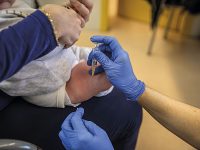
Venereal diseases were a heavy burden in the early twentieth century. Syphilis was the paradigm of physical
and psychological degeneration, the destroyer of family and society, and the syphilitic individual was the subject of eugenic strategies: isolation, sterilisation and, in extreme cases, extermination. In the early twentieth century, statistics showed that close to 16% of the population of Paris was infected. The British Medical Association warned that, between 1880 and 1887, the number of men incapacitated by syphilis had tripled in Great Britain. Mortality statistics, collected by British insurance companies, revealed that 11% of deaths were due to syphilis. The situation was so alarming that, between 1898 and 1902, two international conferences were held in Paris and Brussels, with the participation of specialists and political authorities, in order to agree on measures against prostitution and venereal diseases.
«The first decade of the twentieth century was crucial for the medical treatment of syphilis patients»
During the first decade of the twentieth century, a great clinical and research effort tried to find a solution. At the Pasteur Institute in Paris, Élie Metchnikoff and Pierre Roux managed to transmit the micro-organism responsible for syphilis between chimpanzees in 1903. They also reproduced syphilitic injuries in the scrotum and cornea of rabbits. In 1905, Fritz Schaudinn and Erich Hoffmann identified the spirochaetes (Treponema pallidum) in infectious material from a human chancre, applying a staining technique that would later be used to identify malaria. At the same time, August von Wassermann was forced to abandon his immunological studies on tuberculosis in order to look for a diagnostic test for syphilis, based on the serum of infected patients. Wassermann developed the test to fix the complement, immediately modified by other serologists. The impact of his research was so important that in 1930 there were 10,000 works in scientific literature about Wassermann’s reaction. At the end of the first decade of the twentieth century, Paul Ehrlich was dedicated to research antimicrobial compounds to fight syphilis. After many trials, he discovered Salvarsan, the most efficient drug before the discovery of penicillin.
Taking all these event into account, the first decade of the twentieth century was crucial for the medical treatment of syphilis patients. The specialists and political authorities who participated in the international conferences were in favour of policy to regulate prostitution with a strict medical control as a prophylactic measure, with the collaboration of governments and municipalities to ensure that the treatment was compulsory and free. In Denmark, that was the case since 1874, so countries could adopt several medical attention options: outpatient case at the health centre or staying at the hospital. However, due to moral reasons, shame, work duties and the price of drugs, the objective of a universal treatment was very difficult to achieve.
The respect to a patient’s privacy and the liability of those who spread the disease consciously had to combine with strong healthcare propaganda, to inform the population that continence was not harmful, and to make patients aware that sexually transmitted diseases were highly contagious and spread across all social groups. The population had to know that venereal diseases attack internal organs, not only skin and mucous membranes, even several years after the original infection. It was a huge legal, moral and health issue, especially in times of war and social crisis, as was the case in Spain during the thirties. This is reflected in the outstanding posters alerting the population and, especially, soldiers, women and wet nurses.





